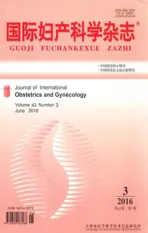炎症与子宫内膜癌的相互影响
2016-03-11李莉莉范江涛
李莉莉,范江涛
炎症与子宫内膜癌的相互影响
李莉莉,范江涛△
炎症与子宫内膜癌的发生、发展密切相关,过量表达的炎症因子往往与疾病密切相关。研究发现,许多恶性肿瘤患者血清中可检测到各种炎症因子的含量超过正常人,肿瘤微环境中的各种炎症介质都有利于肿瘤的增殖、迁移以及血管形成,并且通过炎症信号通路抑制肿瘤细胞的凋亡,子宫内膜癌亦是如此。炎症可通过各种炎症因子和炎症细胞促进子宫内膜癌的发生、发展,而子宫内膜癌也可表现为多种炎症特性,这都有助于子宫内膜癌的增殖和转移,抑制炎症通路可能成为治疗子宫内膜癌的一种干预措施。因此,探讨炎症与子宫内膜癌的相关性具有重要的临床意义。现就炎症与子宫内膜癌的相互影响进行综述,以期为子宫内膜癌的治疗提供新思路。
炎症;子宫内膜肿瘤;癌;炎症趋化因子类
(J Int Obstet Gynecol,2016,43:323-326)
现在大多数的观点认为炎症可以通过各种炎症因子刺激导致恶性肿瘤的发生,同样,肿瘤微环境也可促进炎症因子的产生,甚至流行病学上与炎症无关的肿瘤也呈现出具有炎症细胞和炎症介质的特征[1]。且长期服用非甾体类抗炎药物(non-steroidal antiinflammatory drugs,NSAIDs)可以显著降低“高危人群”恶性肿瘤的患病风险。例如在结肠癌的研究中,应用阿司匹林可预防结肠癌的发生[2],并且可以降低病死率[3]。阿司匹林作用机制可能与环氧化酶1 (COX-1)和COX-2的抑制有关[4]。在活体恶性肿瘤模型中,阻断细胞因子信号通路可以降低肿瘤的生长速度甚至使肿瘤消退。
子宫内膜癌是西方发达国家中最常见的妇科恶性肿瘤[5]。大量的流行病学数据提示雌、孕激素之间的不平衡是导致子宫内膜癌的病因,其中未产、晚绝经、雌激素替代疗法(estrogen hormone replacement therapy,HRT)[6]、初潮早以及体质量指数(BMI)高[7]是患子宫内膜癌的危险因素。这些危险因素具有的共同特征是增加或延长了对雌激素的暴露。由于没有足够孕激素的对抗,在长期高雌激素水平下发生子宫内膜增生甚至异型增生、癌变。
诸多子宫内膜癌的危险因素可以促进炎症的过程,而炎症反应的过程可能与雌激素共同或协同作用,在子宫内膜癌的发生、发展中起重要作用。对炎症及炎症环境在始发和促进恶性肿瘤,尤其是子宫内膜癌的过程中的作用进行综述,对炎症通路的干预可能成为治疗子宫内膜癌的靶点之一。
1 炎症与恶性肿瘤的联系
1.1 细胞因子与恶性肿瘤相关性炎症细胞炎症因子与恶性肿瘤密切相关。肿瘤坏死因子α(TNF-α)、白细胞介素6(IL-6)和IL-1是恶性肿瘤微环境中研究较多的炎性细胞因子。动物模型的数据证明来源于恶性肿瘤细胞的TNF-α能够促进皮肤、卵巢、胰腺和胸膜腔肿瘤的生长和扩散。TNF-α是胃癌腹膜转移的危险因素[8]。也有研究表明,血清TNF-α和IL-32也可作为胃癌的诊断标记,而IL-29对胃癌却无诊断价值(P=0.627),可能与胃癌预后有关[9]。可见,并非所有炎症因子都与恶性肿瘤有关。
IL-6是另外一种调节急性炎症的主要因子,同样在一系列恶性肿瘤模型实验中显示出具有肿瘤促进的作用[10-11],体内子宫内膜癌动物模型成瘤实验证明,IL-6过表达可使成瘤体积增大[12],被认为与多种人类恶性肿瘤有关,如胃癌[13]。在血液来源的恶性肿瘤中IL-6可作为一种自分泌或旁分泌的生长因子,通过激活的信号转导和转录激活因子3(STAT3)途径阻断细胞凋亡过程,抑制STAT3活性则可抑制肿瘤的生长[13]。另外,IL-6具有促血管形成的特性[10],晚期恶性肿瘤患者血清中高水平的IL-6与患者预后有关。结肠炎体内的IL-8和TNF-α可诱导和刺激甲壳质酶蛋白40(YKL-40)产生,从而使YKL-40通过核因子κB(NF-κB)信号通路促进结肠炎向肿瘤发展[14]。
1.2 NF-κB在炎症与恶性肿瘤关联中的作用实验室数据表明,恶性肿瘤与炎症关系中的分子通路涉及到了NF-κB及其抑制因子IκB激酶(IKK)复合物[15]。NF-κB是调节凋亡、细胞增生、细胞生长捕获,以及通过血管内皮生长因子(VEGF)的表达增强血管形成的转录因子。在恶性肿瘤中,NF-κB被激活后呈现出许多炎症的特征。在慢性炎症组织中,NF-κB已被证明参与了肿瘤的发展。例如,在胶质瘤中,NF-κB RelB蛋白调节YKL-40促进肿瘤的增长[16],NF-κB RelB蛋白表达水平高的肿瘤患者生存期短。这些数据表明,由促炎细胞因子激活的NF-κB通过抑制细胞凋亡和刺激更多的促炎细胞因子产生发挥促肿瘤作用。这些促炎细胞又可以反馈性地通过NF-κB通路,进一步促进增生、抗凋亡和促炎症过程。因此,暴露于慢性炎症或促炎环境中的组织更易向恶性转化。
2 子宫内膜癌与炎症
2.1 子宫内膜的周期性变化与慢性炎症过程子宫内膜的周期性变化也与慢性炎症的形成有关[17]。人类月经周期由Finn在1986年首次被阐释为如同炎症创伤的愈合过程,包括血流和血管通透性增加,间质组织的分化(蜕膜化),与创伤愈合过程中的肉芽组织形成及免疫细胞浸润相仿。
在月经期,大量免疫细胞如自然杀伤(NK)细胞、巨噬细胞、中性粒细胞、嗜酸性粒细胞汇聚,是月经期中显著的炎症特点[18]。月经期中,炎性趋化因子(如巨噬细胞炎性蛋白1α)从裸露的上皮中释放,促进巨噬细胞的浸润,在组织破坏和促凋亡中起作用。在子宫内膜的增生期内,逐渐增加的雌激素和局部产生的血管生成和生长因子促进了子宫内膜生长。这些细胞因子的上调可导致巨噬细胞和中性粒细胞的浸润。中性粒细胞出现在脉管系统周围,产生VEGF,因此参与了脉管的重塑。在分泌中期,子宫内膜处于准备接受受精卵的时期。在这个阶段,众多细胞因子的表达上调,包括IL-11、白血病抑制因子(LIF)和IL-6[19]。这些因子被认为有助于受精卵黏附和侵入子宫内膜。
2.2 子宫内膜癌中的性激素和炎症越来越多的数据表明雌、孕激素通过调节子宫内膜中的细胞因子和生长因子的生成发挥对子宫内膜、间质和血管周围的影响。雌激素可以影响炎症过程,上调IL-6的表达。雌激素通过诱导VEGF和碱性成纤维细胞生长因子(bFGF)的产生激活丝裂原活化蛋白激酶(MAPK)信号通路促进子宫内膜癌细胞的发生、发展[20]。体外实验证明,外源性雌激素可诱导NF-κB的活化,增加子宫内膜癌Ishikawa细胞的增殖和迁移能力[21]。雌激素撤退引起子宫内膜基质细胞的周期性变化以及炎症因子的聚集[17]。
孕激素可以下调许多炎症介质的水平。许多体外研究证明孕激素能够抑制细胞因子从鼠及人子宫内膜癌细胞中释放。孕激素同样能够刺激前列腺素脱氢酶生成,抑制细胞因子诱导的COX-2转录,从而降低前列腺素生成以及随之发生的炎症反应。这在动物月经周期模型中得到证实[22]。
反之,子宫内膜癌中的促炎环境可以直接促进雌二醇的产生。IL-6能够刺激雌二醇的合成,与TNF-α协同作用增加芳香化酶、17β羟基脱氢酶和硫酸雌酮的活性,TNF-α能够以潜在的自分泌或旁分泌调节因子的作用影响子宫内膜类固醇的合成。因此,促炎环境同样可以在雌、孕激素失衡方面起作用,从而促进子宫内膜的恶性转化。
2.3 炎症介质在子宫内膜癌中的作用
趋化因子是细胞因子家族中的亚类,子宫内膜癌中趋化因子受体CXCR4表达上调,这种受体被趋化因子CXCL12(又称间质细胞源性因子-1)激活。在子宫内膜癌的裸鼠移植瘤模型中可以检测到CXCR4表达上调,尽管其高表达与肿瘤高转移率有关,但并不是趋化因子表达高者其生存期皆短。
3 结语
子宫内膜癌表现出多种炎症特性,如细胞因子表达、白细胞浸润和组织重塑。炎症同样可以促进子宫内膜癌的发展。炎症与子宫内膜癌之间的关系尚需进一步探索。炎症可能通过特定的信号通路对子宫内膜癌进行干预,因此,正如阿司匹林可用来预防结肠癌的发生、发展[31],抑制和干扰炎症形成过程中的信号因子,以及在炎症消退过程中进行操控,可能成为子宫内膜癌的治疗方向。
[1]Balkwi ll FR,Mantovani A.Cancer-related inflammation:common themes and therapeutic opportunities[J].Semin Cancer Biol,2012,22 (1):33-40.
[2]Izano M,Wei EK,Tai C,et al.Chronic inflammation and risk of colorectal and other obesity-related cancers:The health,aging and body composition study[J].Int J Cancer,2016,138(5):1118-1128.
[3]Li P,Wu H,Zhang H,et al.Aspirin use after diagnosis but not prediagnosis improves established colorectal cancer survival:a metaanalysis[J].Gut,2015,64(9):1419-1425.
[4]Liao X,Lochhead P,Nishihara R,et al.Aspirin use,tumor PIK3CA mutation,and colorectal-cancer survival[J].N Engl J Med,2012,367(17):1596-1606.
[5]Doll A,Abal M,Rigau M,et al.Novel molecular profiles of endometrial cancer-new light through old windows[J].J Steroid Biochem Mol Biol,2008,108(3/4/5):221-229.
[6]Jordan SJ,Wilson LF,Nagle CM,et al.Cancers in Australia in 2010 attributable to andpreventedby the use ofcombinedoral contraceptives[J].Aust N Z J Public Health,2015,39(5):441-445.
[7]Benedetto C,Salvagno F,Canuto EM,et al.Obesity and female malignancies[J].Best Pract Res Clin Obstet Gynaecol,2015,29(4):528-540.
[8]Guo L,Ou JL,Zhang T,et al.Effect of expressions of tumor necrosis factor α and interleukin 1B on peritoneal metastasis of gastric cancer [J].Tumour Biol,2015,36(11):8853-8860.
[9]Erturk K,Tastekin D,Serilmez M,et al.Clinical significance of serum interleukin-29,interleukin-32,and tumor necrosis factor alpha levels in patients with gastric cancer[J].Tumour Biol,2015. [Epub ahead of print]
[10]Chen XW,Zhou SF.Inflammation,cytokines,the IL-17/IL-6/ STAT3/NF-κB axis,and tumorigenesis[J].Drug Des Devel Ther,2015,9:2941-2946.
[11]De Simone V,Franzè E,Ronchetti G,et al.Th17-type cytokines,IL-6 and TNF-α synergistically activate STAT3 and NF-kB to promote colorectal cancer cell growth[J].Oncogene,2015,34(27):3493-3503.
[12]Che Q,Liu BY,Wang FY,et al.Interleukin 6 promotes endometrial cancer growth through an autocrine feedback loop involving ERK-NF-κB signaling pathway[J].Biochem Biophys Res Commun,2014,446(1):167-172.
[13]Xia Y,Khoi PN,Yoon HJ,et al.Piperine inhibits IL-1β-induced IL-6 expression by suppressing p38 MAPK and STAT3 activation in gastric cancer cells[J].Mol Cell Biochem,2015,398(1/2):147-156.
[14]Chen CC,Pekow J,Llado V,et al.Chitinase 3-like-1 expression in colonic epithelial cells as a potentially novel marker for colitisassociated neoplasia[J].Am J Pathol,2011,179(3):1494-1503.
[15]Martin BN,Wang C,Willette-Brown J,et al.IKKα negatively regulates ASC-dependent inflammasome activation[J].Nat Commun,2014,5:4977.
[16]Lee DW,Ramakrishnan D,Valenta J,et al.The NF-κB RelB protein is an oncogenic driver of mesenchymal glioma[J].PLoS One,2013,8 (2):e57489.
[17]Evans J,Salamonsen LA.Decidualized human endometrial stromal cellsare sensors of hormone withdrawal in the menstrual inflammatory cascade[J].Biol Reprod,2014,90(1):14.
[18]GraziottinA,ZanelloPP.Menstruation,inflammationand comorbidities:implications for woman health[J].Minerva Ginecol,2015,67(1):21-34.
[19]Maybin JA,Critchley HO.Menstrual physiology:implications for endometrial pathology and beyond[J].Hum Reprod Update,2015,21 (6):748-761.
[20]卢燕琼,蒋斯,张洁清,等.雌二醇诱导子宫内膜癌细胞产生的VEGF和bFGF对MAPK通路的影响[J].中华妇产科杂志,2014,49(12):925-931.
[21]宋红林,梁少凤,张洁清,等.雌二醇经丝苏氨酸蛋白激酶激活核因子κB通路对子宫内膜癌Ishikawa细胞增殖迁移的影响[J].中华肿瘤杂志,2014,36(11):811-815.
[22]Xu X,Chen X,Li Y,et al.Cyclooxygenase-2 regulated by the nuclear factor-κB pathway plays an important role in endometrial breakdowninafemalemousemenstrual-likemodel[J]. Endocrinology,2013,154(8):2900-2911.
[23]Smith HO,Stephens ND,Qualls CR,et al.The clinical significance of inflammatory cytokines in primary cell culture in endometrial carcinoma[J].Mol Oncol,2013,7(1):41-54.
[24]GianniceR,ErreniM,AllavenaP,etal.ChemokinesmRNA expression in relation to the Macrophage Migration Inhibitory Factor (MIF)mRNA and Vascular Endothelial Growth Factor(VEGF)mRNA expression in the microenvironment of endometrial cancer tissue and normal endometrium:a pilot study[J].Cytokine,2013,64 (2):509-515.
[25]Friedenreich CM,Langley AR,Speidel TP,et al.Case-control study of inflammatory markers and the risk of endometrial cancer[J].Eur J Cancer Prev,2013,22(4):374-379.
[26]Nair S,Nguyen H,Salama S,et al.Obesity and the Endometrium: Adipocyte-Secreted Proinflammatory TNF α Cytokine Enhances the Proliferation of Human Endometrial Glandular Cells[J].Obstet Gynecol Int,2013,2013:368543.
[27]Wallace AE,Gibson DA,Saunders PT,et al.Inflammatory events in endometrial adenocarcinoma[J].J Endocrinol,2010,206(2):141-157.
[28]Wallace AE,Sales KJ,Catalano RD,et al.Prostaglandin F2alpha-F-prostanoid receptor signaling promotes neutrophil chemotaxis via chemokine(C-X-C motif)ligand 1 in endometrial adenocarcinoma [J].Cancer Res,2009,69(14):5726-5733.
[29]Husseinzadeh N,Davenport SM.Role of toll-like receptors in cervical,endometrial and ovarian cancers:a review[J].Gynecol Oncol,2014,135(2):359-363.
[30]Ma X,Hui Y,Lin L,et al.Clinical significance of COX-2,GLUT-1 and VEGF expressions in endometrial cancer tissues[J].Pak J Med Sci,2015,31(2):280-284.
[31]Farag M. Can Aspirin and Cancer Prevention be Ageless Companions?[J].J Clin Diagn Res,2015,9(1):XE01-XE03.
The Relationship between Inflammation and Endometrial Cancer
LI Li-li,FAN Jiang-tao.Department of Gynecology,
The First Affiliated Hospital of Guangxi Medical University,Nanning 530021,China
FAN Jiang-tao,E-mail:jiangtao_fan1969@163.com
Recent evidences show that inflammation plays a significant role in the development of endometrial cancer. Overexpressing of inflammatory factors is often closely related to the diseases.Studies detected that serum inflammatory factor level in cancer patients is higher than normal people.Inflammatory mediators in the tumor microenvironment are conducive to the tumor proliferation,migration and angiogenesis.And the chemokine might inhibit the apoptosis of tumor cells through the inflammatory signaling pathways.So is in endometrial cancer.Inflammation can promote the development of the endometrial cancer through a variety of inflammatory factors and inflammation cells,and endometrial cancer also shows a variety of inflammatory features,which can help the cancer cells to proliferate and metastasize.Inhibiting inflammatory pathways may become a kind of interventions for the treatment of endometrial cancer.So it is important to explore the correlation between inflammation and endometrial cancer.This paper reviewed the relationship between inflammation and endometrial cancer,providing a new method for the treatment of endometrial cancer.
Inflammation;Endometrial neoplasms;Carcinoma;Chemokines
2015-11-20)
[本文编辑 王昕]
国家自然科学基金(81360388)
530021南宁,广西医科大学第一附属医院妇科
范江涛,E-mail:jiangtao_fan1969@163.com
△审校者
